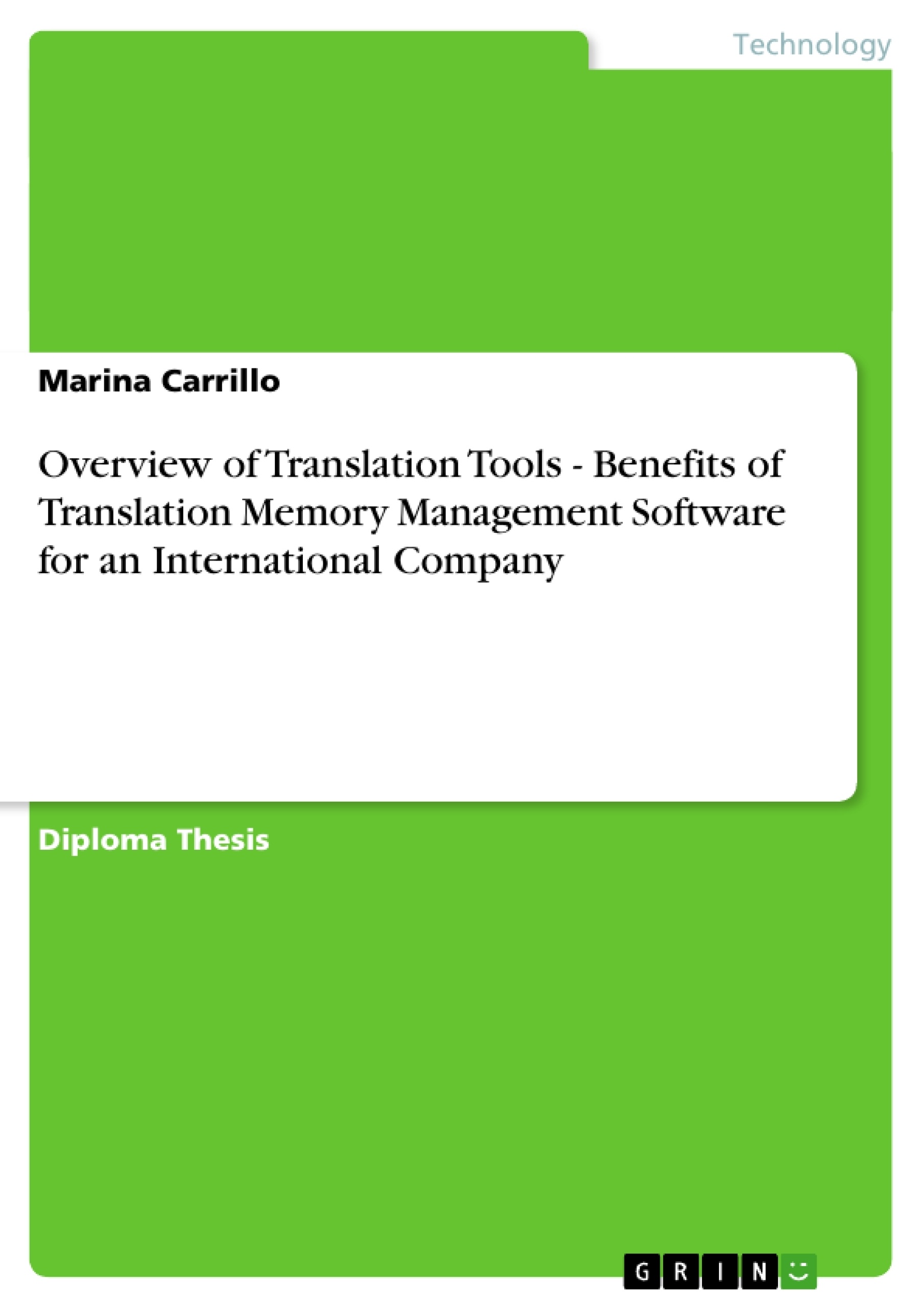“TRANSLATION is very much like copying paintings.” These are the words of Boris Pasternak (1890-1960), a Russian Poet, Novelist and Translator. The key to translation is not only understanding and being fluent in more than one language and having an understanding of language and culture, but also being able to convey the meaning of the text in one language into the other. However, just the knowledge of different languages is not enough to succeed in the competing world scene of translation. Through the immense development of the Internet, information technology, and ongoing globalization, “translation complexity takes a quantum leap” and forces today’s translators to use computer technology, advanced software applications, and computer-aided translation tools to meet enhanced translation requirements in a timely manner. In order to be successful translator in today’s fast turn around times, the knowledge of and skills in different translation facilitating programs are essential. Translation is a difficult process, which requires computer and software skills in addition to proficiency. The translation business is quickly becoming one of the fastest growing markets in the world, and as a result, translators must develop efficiencies in their processes to meet the increasing demand and to be able to offer competitively priced services.
The purpose of this thesis is to analyze the major translation tools available in the marketplace and to illustrate how they benefit the translator in multiple ways. This thesis will combine the essential knowledge of these different software tools and provide the important criteria required to choose the appropriate foreign language translation software.
Inhaltsverzeichnis (Table of Contents)
- Purpose and Course of Action
- Analysis of the Translation Market
- Impact of the Internet
- Increase in Demand for Translations
- Translation Market
- Definition of Language Translation
- Development of the Translation Market
- The Market of Machine Translation
- Human Translation
- Translation and Translation Management Tools
- Machine Translation
- Brief History of the Machine Translation
- Basic Features and Terminology
- Direct Translation Systems
- Rule-based Translation
- Interlingual Systems
- Transfer Systems
- Corpus-based Methods
- Statistical Machine Translation
- Example-based Machine Translation
- Hybrid Approaches
- Controlled Language, Domain-specific and User-specific Systems
- Evaluation of Machine Translation
- IR-style Techniques
- BLEU
- NIST
- F-measure
- METEOR
- String Matching Techniques
- IR-style Techniques
- Reasons to use Machine Translation
- Open Source and Commercial Software
- Return on Investment
- Summary
- Translation Memory
- The Concept of Translation Memory
- Translation Process, and Effects of TM on Translation Process
- Internal Attributes
- Terminology Databases
- Analysis
- Common Standards and Products
- Adequate Texts for TM Usage
- Consideration of the documents
- Updates
- Revisions
- Consideration of the documents
- Advantages and Drawbacks of TM
- Overview of currently available TM Products
- Classical TM Tools
- TM/MT Hybrids
- Localization Software with TM
- Cost-effectiveness of TM
- Summary
- Globalization and Localization Software
- Introduction to Globalization and Localization
- Differentiation of Terminology
- Organizations for the Globalization, Internationalization, and Localization
- LISA
- W3C
- ISO 61
- Benefits of Internationalized Software Application
- Conclusion
- Proposal for XY Company for Use of Translation Memory Tool
- Company Profile
- Operating Manuals (OPM)
- Current Translation Process of Operating Manuals
- Disadvantages of a Conventional Translation Process
- How Translation Memory Tool Can Benefit the Company
- How Documentation from the Company is Suitable for TM
- Benefits from TM
- Proposal to Purchase Transit TM from STAR AG
- STAR AG Brief Company Description
- STAR AG TransitⓇ Translation Memory
- Key Benefits for XY of Transit TM
- System Requirements
- Installation or Transit TM
- Additional Software Required to Work with Transit TM
- Cost Transit TM
- Conclusion
Zielsetzung und Themenschwerpunkte (Objectives and Key Themes)
This thesis explores the various tools and software available within the translation market, focusing on the benefits of translation memory management software for international companies. It aims to provide a comprehensive overview of these solutions, emphasizing their importance in establishing a successful translation business.
- The impact of the Internet and the increasing demand for translations.
- The development and characteristics of machine translation and translation memory.
- The benefits and limitations of different translation tools, particularly translation memory management.
- The application of translation memory software in a specific business context.
- The cost-effectiveness of translation memory management software.
Zusammenfassung der Kapitel (Chapter Summaries)
Chapter 1 introduces the purpose and scope of the thesis, outlining its key objectives and areas of focus. Chapter 2 provides a detailed analysis of the translation market, examining the impact of the Internet and the rising demand for translations. It delves into the market's development, including the evolution of both machine translation and human translation.
Chapter 3 dives into the core theme of translation tools, with a particular emphasis on machine translation and translation memory. It explores the historical background, key features, and evaluation methods of machine translation systems. The chapter also thoroughly analyzes the concept, process, and benefits of translation memory, examining its implementation and impact on translation workflow. Additionally, it provides an overview of different translation memory products and addresses the cost-effectiveness of this software.
Chapter 4 presents a proposal for a specific company, XY Company, advocating for the adoption of a translation memory tool to streamline their translation process. It analyzes the company's current translation practices, identifies potential disadvantages, and outlines the benefits of implementing translation memory software. The chapter concludes with a detailed proposal for a specific translation memory product, Transit TM from STAR AG.
Schlüsselwörter (Keywords)
Translation market, machine translation, translation memory, globalization, localization, software tools, cost-effectiveness, international companies, operating manuals, technical documentation.
- Machine Translation
- Quote paper
- Marina Carrillo (Author), 2007, Overview of Translation Tools - Benefits of Translation Memory Management Software for an International Company, Munich, GRIN Verlag, https://www.grin.com/document/77208



